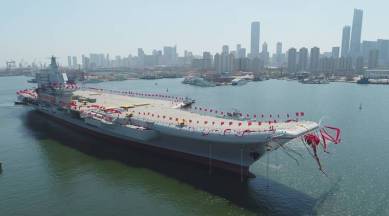Stay updated with the latest - Click here to follow us on Instagram
China to boost regional influence with its first domestically-made aircraft carrier: 8 facts
If Chinese reports are anything to go by, then the carrier will likely carry at least 24 Shenyang J-15 fighters, which are based on the Russian Sukhoi Su-33.

In an effort to boost its blue-water capabilities, China launched its first indigenously-built aircraft carrier on Wednesday. It comes at a time when several countries such as Philippines, Taiwan, Malaysia, Vietnam, Brunei and China are locked in a bitter war of words over control of a group of South China Sea islands seemingly rich in natural resources. This development will also give Beijing more room to strategise and flex its muscles in the disputed islands. The 50,000-tonne new aircraft carrier was transferred from a dry dock into the water at a launch ceremony in northeast Dalian shipyard of the China Shipbuilding Industry Corp (CSIC) amid streamers and champagne.
Here are 8 quick facts about the aircraft carrier and how India is likely to react:
monthly limit of free stories.
with an Express account.
1. The yet-to-be-named vessel is China’s second aircraft carrier. It was towed from Dalian Shipyard, Liaoning, to a nearby wharf, according to the China’s Ministry of National Defense.
2. The construction work had started in November 2013, while dock construction started in March 2015. The carrier, however, is not likely to enter active service until 2020. The launch is also seen by China as a marked progress in its efforts to design and eventually construct a domestic aircraft carrier. The defence ministry also said that the new carrier will have to undergo equipment debugging, outfitting and comprehensive mooring trials.
3. The unnamed vessel is believed to be a significant upgrade from the Liaoning, which was built almost 25 years ago and is a refurbished Soviet ship bought from Ukraine.
4. Although the carrier looks quite similar to the Liaoning, military experts say the carrier will have an advanced operational concept, layout and equipment to accomodate a bigger hangar to house more J-15 fighter planes. With this layout, it is likely to leave more space on deck for helicopters and other aircraft.
5. If Chinese reports are anything to go by, then the carrier will likely carry at least 24 Shenyang J-15 fighters, which are based on the Russian Sukhoi Su-33. This coupled with 12 helicopters for anti-submarine warfare. That compares to 85-90 fixed wing aircraft and helicopters carried by a Nimitz-class carrier.
6. The new carrier is based on the the Soviet Kuznetsov class design, unlike the Liaoning that was bought from the Ukraine. It also has a ski jump-style deck for taking off and a conventional oil-fueled steam turbine power plant. What does all this mean? It limits the weight of the payloads its planes can carry, its speed and the amount of time it can spend at sea relative to American nuclear-powered carriers.
7. The launch comes close on the heels of heated parleys between the US and North Korea in recent weeks even as US has deployed warships to the Korean peninsula. US’ actions have elicited angry reactions from North Korea.
8. The new carrier is also a crucial part of China’s naval expansion as it looks to flex its muscles in the diputed South China Sea islands. For Beijing, the launch comes at a time when it is looking to increase its regional military influence to match its economic might. While China maintains that all of this is only a defensive military policy, its neighbours clearly see it as a growing threat which can add fuel to the fire in the region. A blue-water navy is a maritime force capable of operating globally across the deep waters of open oceans.
How is India likely to react ?
According to Ian Easton, a research Fellow at the Project 2049 Institute in Vigrinia, India, along with Japan and Taiwan which also view Chinese carriers as threats, will likely respond by building new submarines and anti-ship missiles, as reported by the Associated Press.